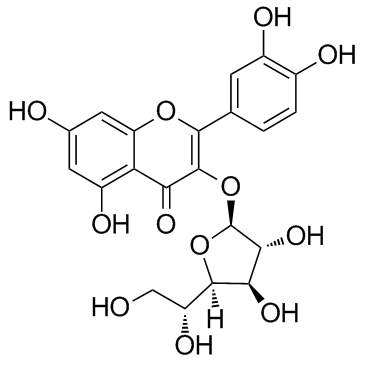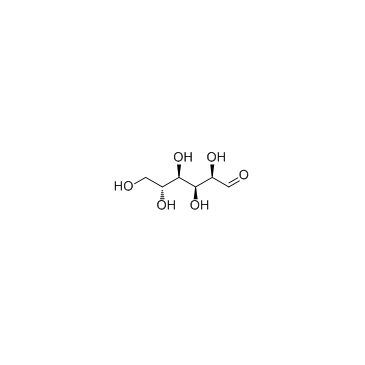21637-25-2
| Name | quercetin 3-O-β-D-glucofuranoside |
|---|---|
| Synonyms |
Quercetin 3-O-β-glucoside
trifoliin 2-(3,4-Dihydroxyphenyl)-5,7-dihydroxy-4-oxo-4H-chromen-3-yl β-D-glucofuranoside quercetin 3-O-β-D-glucopyranoside Quercetin 3β-O-glucoside 4H-1-Benzopyran-4-one, 2-(3,4-dihydroxyphenyl)-3-(β-D-glucofuranosyloxy)-5,7-dihydroxy- 4H-1-Benzopyran-4-one, 2-(3,4-dihydroxy-phenyl)-3-(β-D-glucofuranosyloxy)-5,7-dihydroxy- Quercetin 3-β-glucoside Quercetin 3-O-glucofuranoside 2-(3,4-Dihydroxyphenyl)-5,7-dihydroxy-4-oxo-4H-chromen-3-yl β-D-glucopyranoside Isopseudopsoralen isopseudopsoralene Quercetin 3-β-D-glucoside quercetin-3-glucoside 3-O-β-D-Glucopyranosylquercetin Quercetin glucoside Isoquercitroside Quercetin-3-O-β-D-glucoside isopseudosporalen Quercetin-3-O-β-glucopyranoside Isoquercetrin Quercetin 3-O-glucoside Quercetin 3-D-glucoside Isoquercitrin isoquercetin quercetin 3-O-β-D-glucoside Hirsutrin isotrifoliin 4H-1-Benzopyran-4-one, 2-(3,4-dihydroxyphenyl)-3-(β-D-glucopyranosyloxy)-5,7-dihydroxy- 3,3',4',5,7-Pentahydroxyflavone 3-b-D-glucofuranoside Quercetin-3-β-glucopyranoside quercetin 3-O-beta-D-glucofuranoside Quercetin-3-O-glucoside Quercetin 3-β-O-glucoside 2-(3,4-Dihydroxyphenyl)-3-(b-D-glucofuranosyloxy)-5,7-dihydroxy-4H-1-benzopyran-4-one Quercetin 3-O-glucopyranoside |
| Description | Isoquercitrin is an effective antioxidant and an eosinophilic inflammation suppressor. |
|---|---|
| Related Catalog | |
| In Vitro | Isoquercitrin occurs widely in plants.10 μM of Isoquercitrin of the seven compounds partially but significantly blunt the negative effect of H2O2 on RGC-5 cells, as the viability of cells in the presence of H2O2 is increased from approximately 63% to 83% and 90% at 10 and 50 μM, respectively. Indeed, 50 μM Isoquercitrin is more effective as a neuroprotectant than the same concentration of EGCG[1]. |
| In Vivo | In animals receiving Isoquercitrin or quercetin, eosinophil counts are lower in the BALF, blood and lung parenchyma. Neutrophil counts in blood and IL-5 levels in lung homogenate are lower only in Isoquercitrin-treated mice. No alterations in mononuclear cell numbers were observed[2]. |
| Animal Admin | Mice[2] BALB/c mice are immunized (ovalbumin/aluminum hydroxide, s.c.), followed by two intranasal ovalbumin challenges. From day 18 to day 22 after the first immunization, the mice receive daily gavages of Isoquercitrin (15 mg/kg) or quercetin (10 mg/kg). Dexamethasone (1 mg/kg, s. c.) is administered as a positive control. Leucocytes are analyzed in bronchoalveolar lavage fluid (BALF), blood and pulmonary parenchyma at 24 h after the last ovalbumin challenge. Interleukin-5 (IL-5) is analyzed in BALF and lung homogenates[2]. |
| References |
| Density | 1.9±0.1 g/cm3 |
|---|---|
| Boiling Point | 872.6±65.0 °C at 760 mmHg |
| Melting Point | 225-227° |
| Molecular Formula | C21H20O12 |
| Molecular Weight | 464.376 |
| Flash Point | 307.5±27.8 °C |
| Exact Mass | 464.095490 |
| PSA | 210.51000 |
| LogP | 1.75 |
| Vapour Pressure | 0.0±0.3 mmHg at 25°C |
| Index of Refraction | 1.803 |
| Storage condition | −20°C |
CHEMICAL IDENTIFICATION
HEALTH HAZARD DATAACUTE TOXICITY DATAMUTATION DATA
|
| Safety Phrases | 24/25 |
|---|---|
| RIDADR | UN 2811 |
| WGK Germany | 3 |
| RTECS | LK8960000 |


